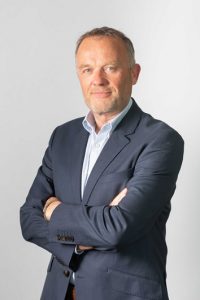Five minutes with… Mark Howard
We catch up with Mark Howard, Head of Commercial Strategy for FlyZero.
NH: What attracted you to join the FlyZero project?
MH: Being able to play a part in the sustainability agenda on a project which I hope will have a lasting positive impact on the future of aerospace in the UK. I’ve worked in aerospace for 35 years so the opportunity to work on what is in some ways the beginning of the new generation of air travel and leave a bit of a legacy by the end of my career is an exciting one.
NH: What does Commercial mean within the FlyZero project?
MH: As a commercial team our focus is on taking a holistic view of all of the economic aspects of zero-carbon emission aviation from the investments required to deliver the advanced technologies to the costs of manufacturing, maintaining and operating them for airlines and airports.
One of the outcomes of FlyZero is assessing the economic and commercial case for zero-carbon aircraft and how, with the right support and investment, the UK aerospace sector could play its part in realising this next generation of air travel.

Mark Howard, Head of Commercial Strategy
As part of this we’re assessing the value for money and return on investment a zero-carbon aviation industry could offer to government not just in terms of technology but also the economic benefits of continued global growth in aviation while meeting our commitments to fight climate change.
To support this we are building a picture of the future market for zero-carbon emission air travel to investigate how competitive these aircraft can be in the next few decades. We need to make sure that that the advanced technological solutions that we’re proposing actually will secure the route to a competitive product, meeting market demand in the coming decades while making the best possible impact on aviation’s overall CO2 emissions.
It’s therefore important to forecast the costs to design, manufacture and operate these aircraft concepts including fuel usage and airport charges which in turn will affect the price passengers pay for a seat. And the operational aspects in the air and on the ground are crucial, creating concept aircraft as productive as conventional aircraft is a must. One of our biggest challenges for this productivity is ensuring a safe and efficient turnaround as we explore the alternative fuels and changes to their integration at airports.
More widely we also need to consider the infrastructure required at airports, signal the challenges of delivery of any new fuel types between their production site and the airport as well as how these new aircraft would integrate into existing airspace.
NH: Why is it important to investigate the Commercial challenges as well as the technology?
MH: Considering the commercial and economic aspects from the start of the project means we can embed these requirements into the development of our aircraft concepts and assessment of them. In short, we don’t want to create aircraft concepts which are not affordable to build, maintain or operate and therefore fly on, they have to meet both our sustainability goals and commercial targets.
NH: How is the Commercial team supporting the delivery of FlyZero?
MH: Members of the commercial team are embedded into each of the challenge teams across FlyZero to bring commercial and economic insights into the decision making early on. For example we’re sense checking the concepts being discussed in terms of their integration into airports, airlines and airspace asking ‘can they be truly competitive?’, ‘How will they operate at different airports?’ and ‘How do they fit into the airspace?’.
We’re also supporting by modelling the costs of the build and operation of the concepts, to help further assess their viability and ensure we’re investigating technologies which are affordable and meet operational requirements.
NH: Finally, where will you fly to on your first zero-carbon emission flight?
MH: It would probably be Italy for the food, the weather, the culture and the unspoiled scenery! But I do hope that it will be possible to reach destinations further afield before too long, in which case I’d be heading to the Caribbean!